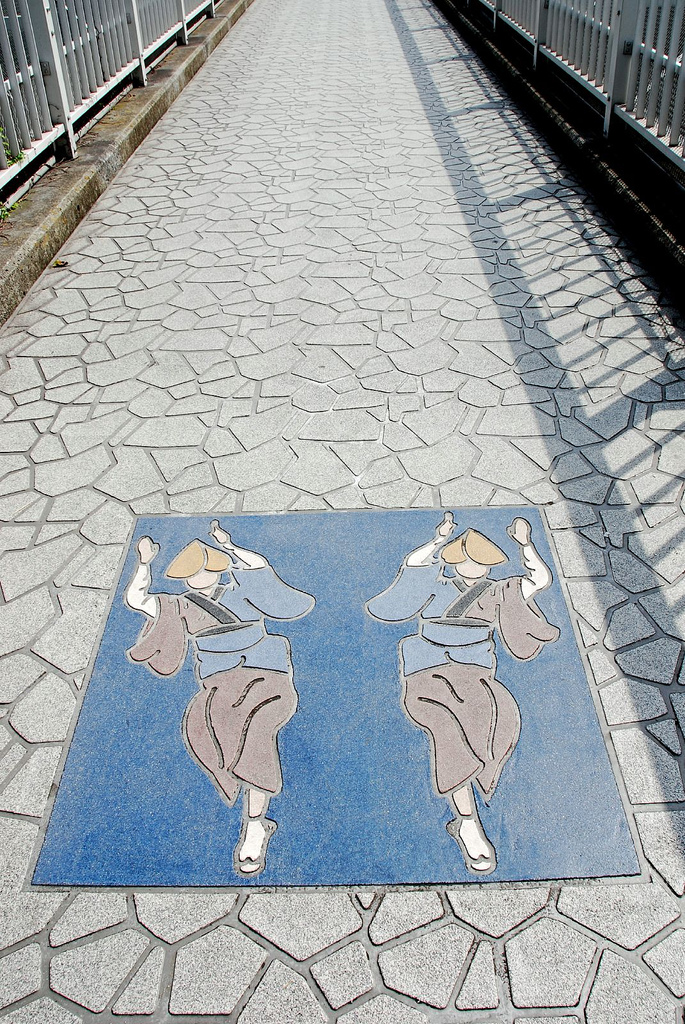
Awa Odori Road tile
The pulsing beat of the taiko drums filled the streets, reverberating through my bones and beckoning me to join the dance. High, almost cacophonous gongs, bells and flutes punctuated the beat, but the drums set the tone for my visit to Tokushima.
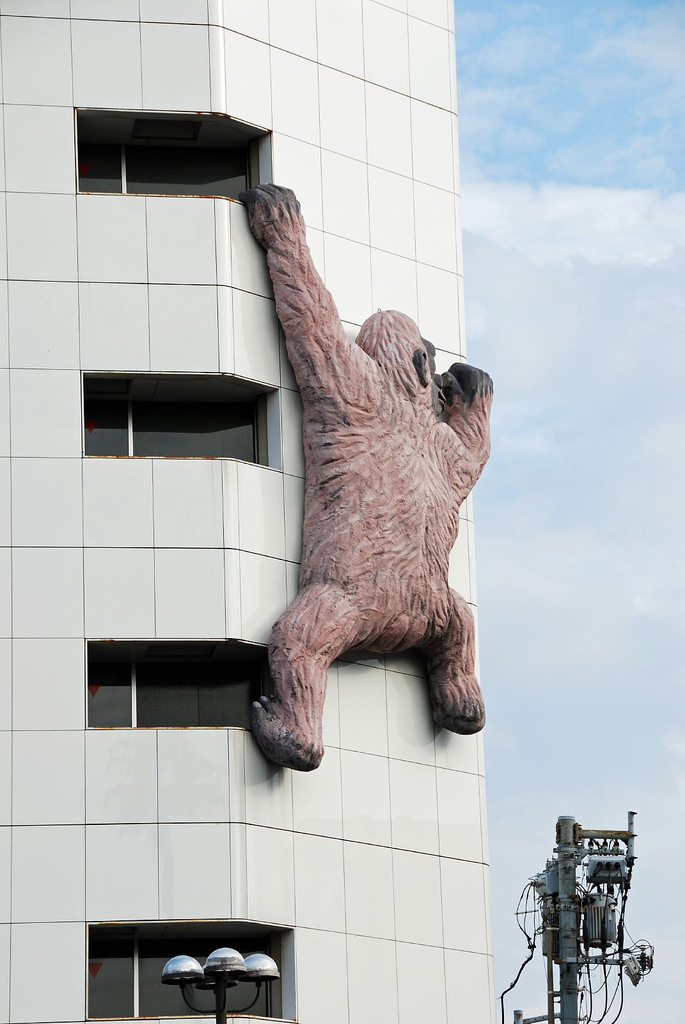
徳島:Tokushima
I love Japan. My friends think I am crazy to spend my holidays traveling to the same country, but there is so much to see and do that every visit is unique. I’ve been to most of the famous tourist spots, so this time wanted to venture farther afield. I had never been to Shikoku, the smallest of the four main islands, but had heard tales. It was supposed to be a backwater place, rough and uncultured. Historically the island was home to bandits and exiles. It was only accessible by boat until less than 40 years ago, when the Seto Ohashi, the long bridge over the Inland Sea, was built. With that reputation, I was a bit nervous about what I would find.
![Pose [江戸っ子連 / 高円寺阿波踊り]](https://www.holidaytravel.cc/Article/UploadFiles/201602/2016022416014195.jpg)
Pose [江戸っ子連 / 高円寺阿波踊り]
I finally made the decision to visit because it was Obon, when the Awa Odori, a traditional dance festival, was held in Tokushima. When I left Osaka, many of the smaller, family-owned stores were closed for the holiday week. It is possible to take a train across the Seto Ohashi, but that arrives on the other side of the island from my destination. Instead I took the highway bus, which proved to be a very comfortable coach like those used on sightseeing trips.
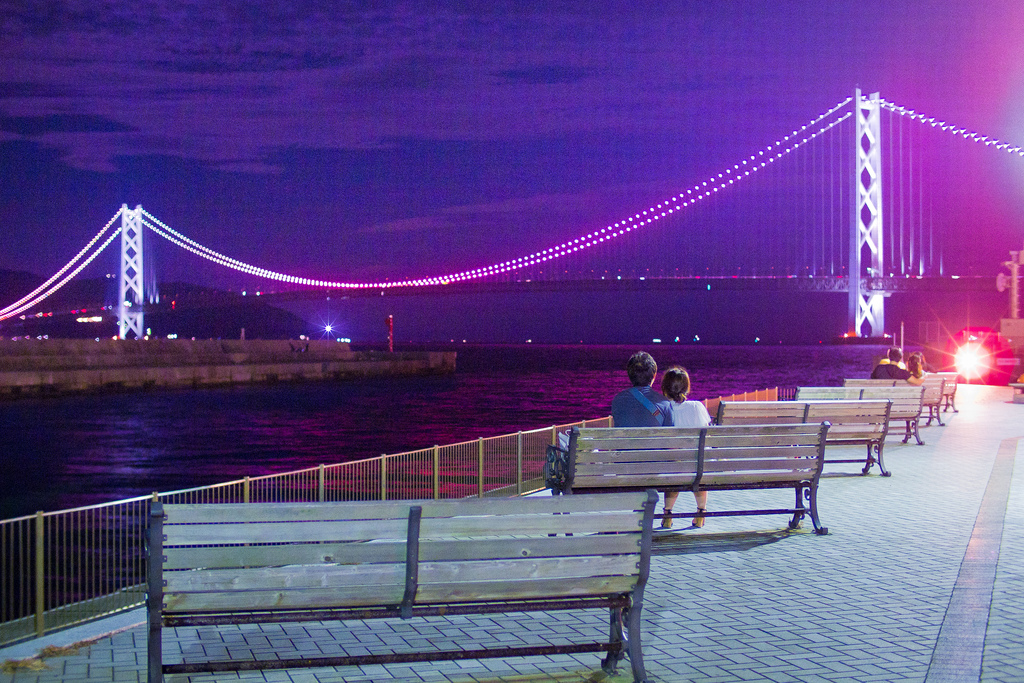
Akashi Bridge
It only took a couple hours to get to Shikoku along the freeway through Kobe and over Akashi Bridge to a large island that seemed populated by more cows than people, over another bridge where I looked in vain for the famous Naruto Whirlpools, and into Tokushima City itself. The bus even stopped at a rest area so passengers could stretch their legs, get snacks at the convenience store, and use the bathrooms.
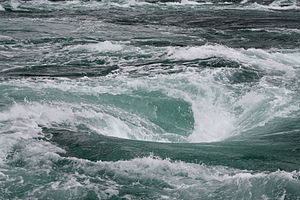
Naruto Whirlpools (Photo credit: Wikipedia)
My plan was simple: find my hotel, the Tokushima Ekimae Dai-Ichi Hotel, then try to figure out where the Awa Odori dances were being held. I needn’t have worried about the latter, the booming of taiko drums greeted me as I left the bus at Tokushima Station. Ekimae means “in front of the station,” and the hotel really was close, much to my relief. The staff did not speak English, but we fumbled through the registration and I found my room to be small but less worn than many business hotels I had stayed in previously.
I took a quick shower to wash off the travel grime. Then I draped a small towel around my neck, not something I would ever do at home, but which is socially acceptable in the oppressive Japanese heat. On the bus, someone had said that it was about 40 degrees, which I calculated to be about 100 degrees Fahrenheit. My problem was that I was not used to the overwhelming humidity.
Stepping out of the air conditioned lobby felt like entering a sauna. I had a fleeting desire to go back inside, but the music was drawing me like a Siren. I knew the Awa Odori was the largest dance festival in the Japan, but was vague on any details.
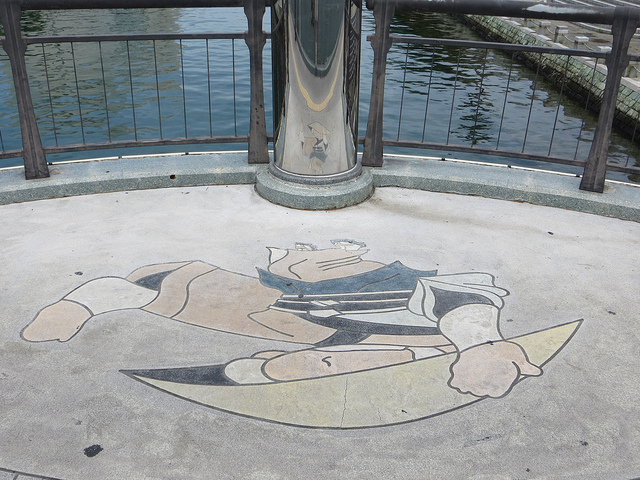
Image of Female Awa Odori dancer on street (photo:flickr.com/photos/40295335@N00)
My first impression was the crowds swarming in all directions so it was hard to move. There were foreigners seeming to melt in the heat. Japanese people were dressed more casually than I was used to seeing in the big cities, many men even wore T shirts and cropped pants. A surprising number of young people were in yukata, the traditional summer kimono made of unlined cotton. The girls looked like exotic birds in the brightly-colored outfits with contrasting sashes and hair ornaments. The men’s outfits were less stifling and looked quite comfortable to me. There were also a lot of dance groups excitedly chattering to each other, pushing through on their way to a new venue.
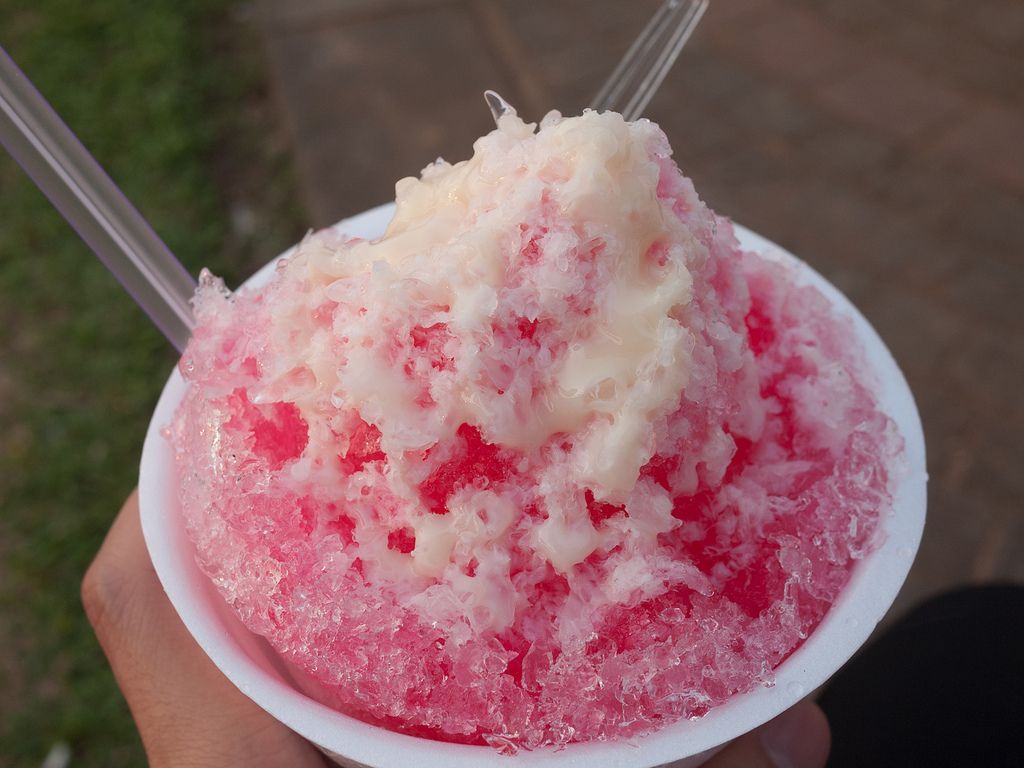
Kakigori
The crowds were thick around the food stalls. There was an overwhelming array of tantalizing dishes, and my first purchase was kakigori, or shaved ice. It gave me nostalgic pleasure, reminding me of snow cones from my youth. However, in Japan, adults also enjoy the treat, so I fit right in. I was intrigued by a local flavoring, sudachi, which was a kind of lime-like citrus. Condensed milk was poured on top as a sweetener.

Awa Odori (photo credit: Nakazawa)
There were dancers running in all directions, but my first sight of an actual performance was a group dressed in brown kimono with UPS written on them. Logically I knew that major companies sponsor the different teams, but I had no idea that the costumes would so blatantly reflect this. Throughout the afternoon, I saw dozens of other troupes decked out with corporate colors and logos. Many of these consisted of company members recruited to participate even if they did not have that much skill or interest. It was quite clear after watching for a few hours the difference between amateur and professional teams.

Awa Odori (photo credit: Owen Legaspi)
The costumes were fascinating. The women wore straw hats that looked like tacos which covered most of their faces. It was paired with what I would call a traditional kimono. They danced on high wooden shoes tipped up onto the toe. It looked hard enough to walk in those shoes, let alone dance in that posture. They waved their arms gracefully in time with the drums, but I had a snide thought that maybe the movement was just to keep their balance. The movements of one individual seemed preposterous, but all dancing together in a group created a graceful waving effect.

Awa Odori (photo credit: Nakazawa)
The men had an energetic and dynamic dance, bending and swaying, jumping and flourishing lanterns or fans. They wore a simpler outfit that looked like colorful working clothes and split-toed shoes that fit like a glove. There were a few women dressed similarly who joined the men’s dances.
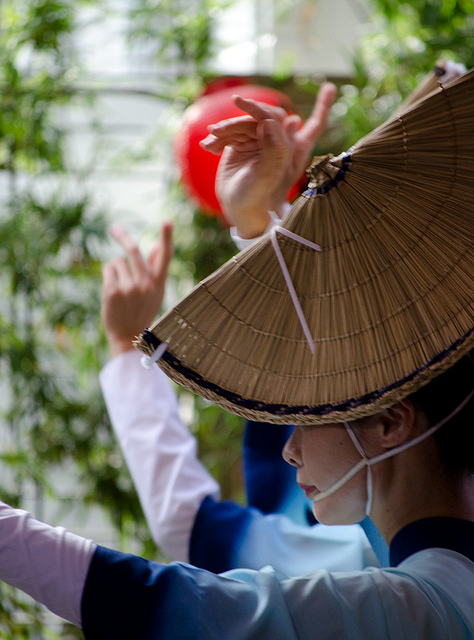
Awa Odori Dancer Closeup (photo: flickr.com/photos/jose-cruz)
The musicians were clad like the dancers, though troupe colors might vary. They carried all sizes of taiko, flutes, bells, and little stringed instruments. They changed the tempo, pushing and challenging the dancers to keep up, letting them relax, pulling the audience into the rhythm.
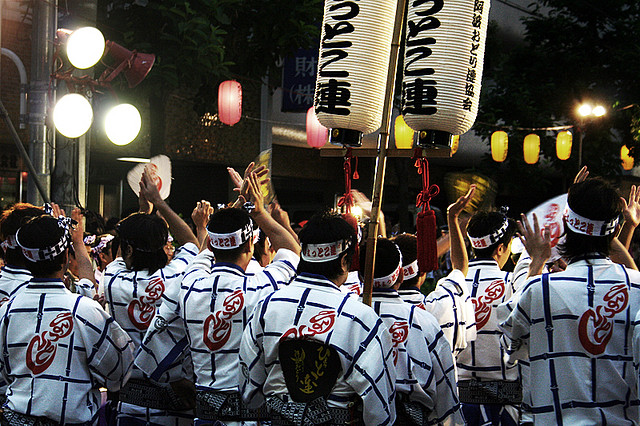
Awa Odori before the dance (photo:flickr.com/photos/fukagawa)
Each troupe also had a person carrying a paper lantern on a long staff, the troupe name written in kanji. There were attendants pulling wagons of drinks. Some handed out flat fans with advertising on them. The attendants would straighten out the kimono and hold out towels for the dancers to wipe off sweat between numbers. Everyone was drenched with sweat; I can’t imagine how they performed in that stifling heat.
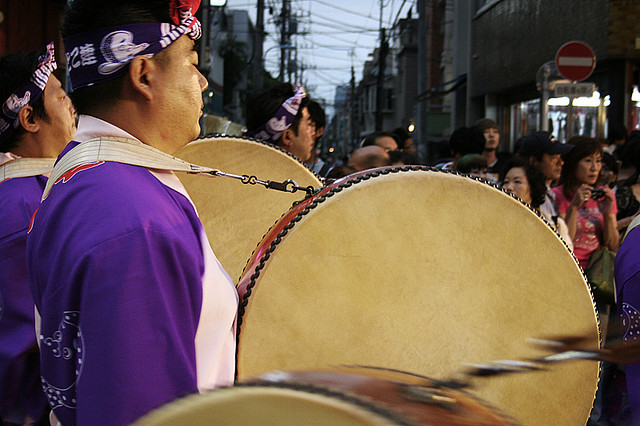
Awa Odori drums (photo:flickr.com/photos/fukagawa)
It was hard for me to figure out how everything was organized. There were lengths of street roped off for dancing, and teams would move down them like a parade. Other areas had circle dances with the musicians forming an arc on one side. Some of these areas had seating, some did not. I ended up just wandering the streets, stopping to watch when something caught my eye.
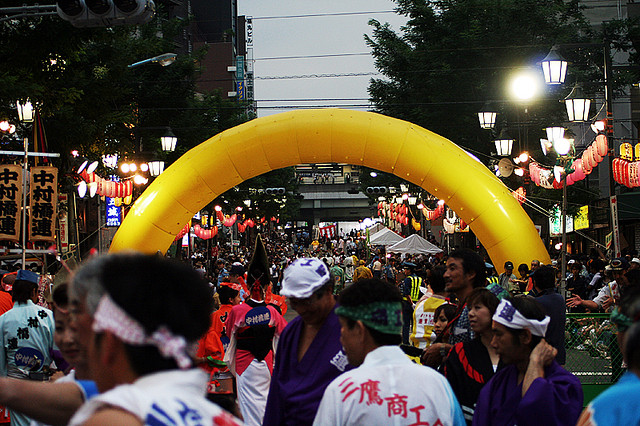
Awa Odori street (photo:flickr.com/photos/fukagawa)
There was one main venue in the heart of the town next to the river. The seating was reserved, but I watched from the opening at the end. It looked like a canyon of spotlights and spectators. There was an announcer and television crews recording the show. It was only about two blocks long, but the dancers took about a half hour to get from one end to the other, pausing and dancing for the crowd before moving a few steps forward. At the end of the run, the pace picked up rather than diminished, the men spinning wildly and the musicians pounding their instruments so I thought the drums would split. Standing at the end was awesome, and my body involuntarily swayed with the music. After a final flourish, the troupe would exit, exhilarated and panting, as the next team entered the stadium.
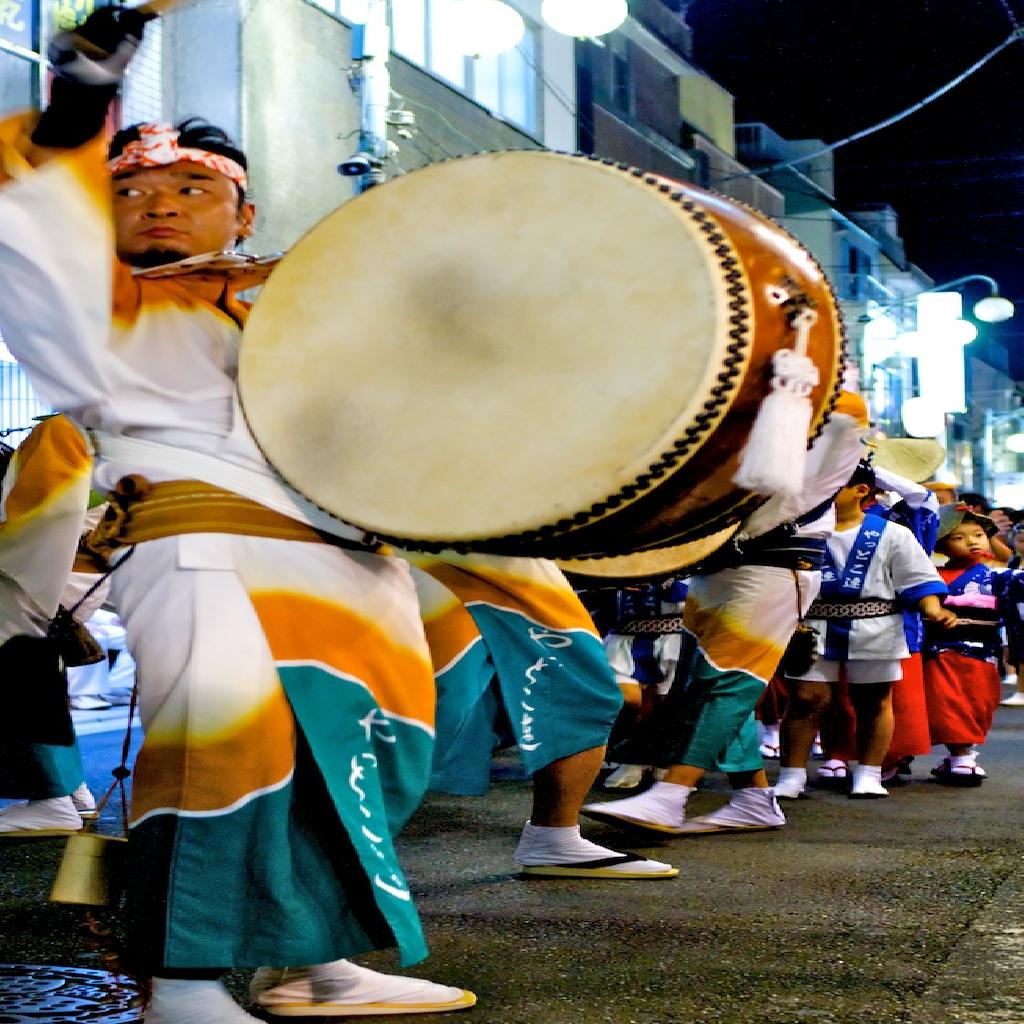
Awa Odori proud_drummer
I walked the town all afternoon and late into the evening, sitting on a railing when I needed a break. The night was lit by orange and yellow paper lanterns, and the costumes looked even more exotic in the dimness. The crowd was energized by the music, and fueled by alcohol. It seemed that most adults were enjoying a cold beer, and I ended up buying one, too.
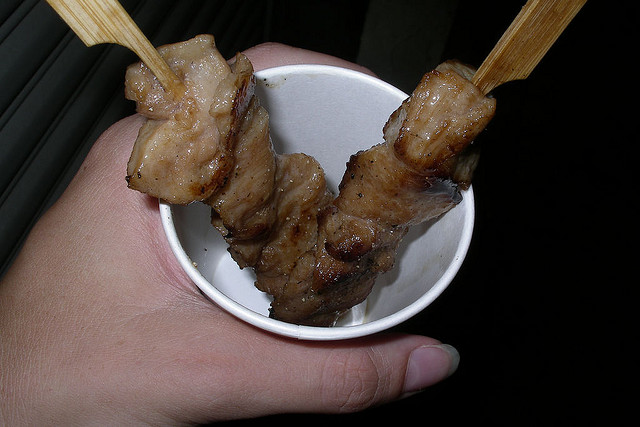
Awa Odori food yakitori (photo:flickr.com/photos/magtravels)
I ate food from the stalls, enjoying yakitori grilled chicken and takoyaki octopus fritters and more kakigori to cool me down. Usually in Japan I have a vague sense of being outside of things; here I felt drawn in and part of the festival. I think it was the music pulling at me, at everyone, to join in.
At last I returned to my hotel, where I showered again and thankfully fell into bed. I would leave Tokushima tomorrow, but tonight my head was filled with the Awa Odori. As I drifted into sleep, I thought of a traditional Awa Odori saying: Dancers are fools, and watchers are fools. Since both are fools, why not dance?
 photos by:
naitokz &
naitokz,
d'n'c,
PhoTones_TAKUMA,
nSeika,
xmatt
photos by:
naitokz &
naitokz,
d'n'c,
PhoTones_TAKUMA,
nSeika,
xmatt